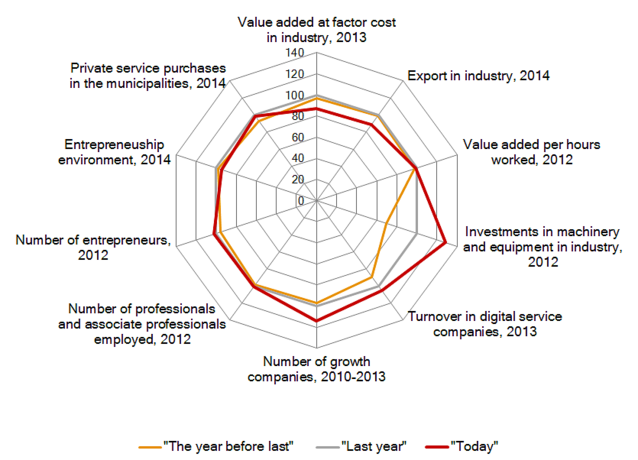The economy in Tampere Region has become modernised through the structural change. Modernisation is reflected in changes in the business structure, an increase in growth companies and entrepreneurship, and in the upgrade rate of hardware. The situation remains a challenging one: measured by export and production indicators, old structures are withering away faster than new ones are being built.
Tampere Region has been among the leading regions in the country for several years in succession when measured by the number of growth companies. The number of growth companies is increasing in various different fields, such as professional support services, construction and the information and communications field. Business activities are growing both in traditional areas and industries that lead in production reformation.
Entrepreneurship has been slightly increasing. The combination of the popularity of entrepreneurship and the increase in growth companies indicates that Tampere Region has the will and ability to succeed and grow in business operations.
Pirkanmaa has a solid foundation in software and IT, and the turnover in digital services has been increasing. For example, the expertise of Nokia and its subcontracting chains has been channelled into new successful business operations. As digitisation strengthens and accelerates, the region will have increasing business opportunities and new jobs.
The structural change in the ICT industry has released a significant number of internationally experienced employees to seek new opportunities. New growing business activities have been created as experts have established new companies and found jobs from existing businesses. Many ICT companies, such as M-Files which has been able to grow steadily, have recruited people merited in the mobile phone industry and used their expertise to increase their international operations.
Industrial investments in machinery have clearly increased in Tampere Region as companies are again able to make investments after the recession and new companies have also invested in the region.
However, the new machinery has not yet resulted in increased production: both the value added at factor cost in manufacturing and the value of exports have continued their decline. Other industrial fields have not been able to patch up the fall of the electronics industry, even though the value added at factor cost has increased in several significant fields, such as the chemical industry and the rubber and plastic industries, during this decade.
The Helsinki-Uusimaa Region, Tampere Region, Southwest Finland and Satakunta Region account for approximately half of the processing value of the nation's industrial production. Industrial centralisation has slightly increased due to new mining areas. Of Finland's regions, Häme Region has grown thanks to the metal industry, while Central Ostrobothnia has grown thanks to the chemical industry.
The value added in proportion to labour hours has maintained its level in Tampere Region in recent years. Above all, this is an indication of unchanged salary levels because the number of people working in professional and associate professional positions has increased only slightly.
The region is looking for new success through smart specialisation and reforms in business structures. Leading research fields include e.g. smart machines, health research, healthcare and bio technologies, optics, photonics and signal processing.
The structural change in the manufacturing industry is expected to produce growth through 3D printing, robotics, the Internet of Things, digital service concepts, open innovation platforms as well as Test Bed and Start-up operations.
The Sastamala Municipal Education and Training Consortium (SASKY), Tampere University of Technology (TTY) and Tampere University of Applied Sciences (TAMK), together with companies operating in the region, are building a competence centre in 3D printing in Tampere Region. The ERDF-funded 3D Invest and 3D Boost project have provided educational institutions with modern learning, research and innovation environments for 3D printing that companies can utilise in the development and testing of their products. The objective is that more extensive use of additive manufacturing technologies (AM technology, 3D printing) will be accelerated within the regional industry. SASKY bulletin, 12 May 2015.
Tampere Region has set up networks with European regions investing in 3D printing through the Vanguard Initiative's “High Performance Production with 3D Printing” pilot. This piloting and demonstration network builds new European and global value chains and strengthens the competitiveness of the involved regions. http://www.s3vanguardinitiative.eu/cooperations/high-performance-production-through-3d-printing
Next: Funding of RDI: A temporary defensive victory or Back to Contents
